
BANNER IMPRESSIONS EXCHANGE REVIEW
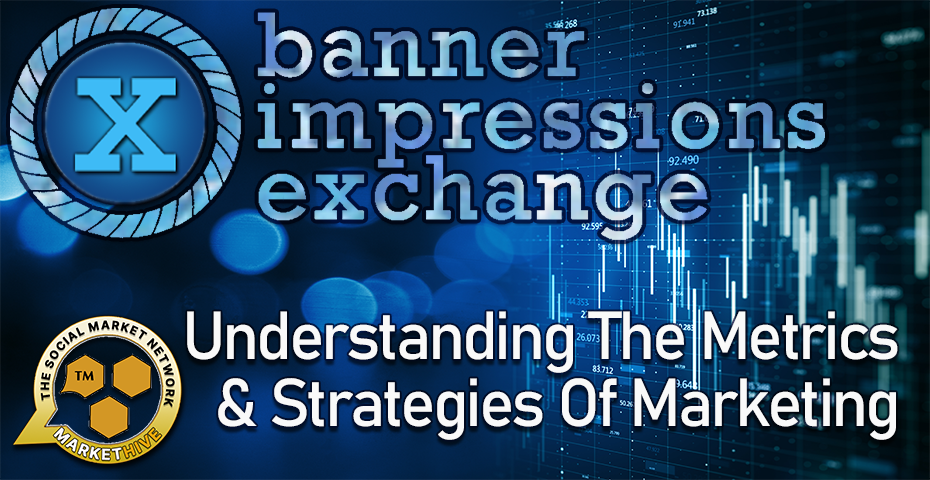
There are many facets to Markethive - It is a complete Market Network and broadcasting platform with a Social Media interface. It has everything you need to succeed in whatever you do online, including the potential of extra revenue made available to Entrepreneur One (E1) associates through the first of many upcoming money machines - The Banner Impressions Exchange.
It is a concept and unprecedented innovation where Markethive returns 100% of the ad-revenue into your pocket. There have been 20+ years of high energy poured into Markethive. This is a Divine inspiration and places all of the members of Markethive first and foremost.
It’s been almost a year since the launch of the Banner Impressions Exchange (BIX), with many seeing great results on both fronts.
Still, many are still unfamiliar with the strategies of metrics and the unique system Markethive offers by sharing its significant and ever-increasing traffic with the community. Given that it’s coming up to the first anniversary of BIX, I thought it appropriate to revise and update the Banner Impressions Exchange features and benefits and how you can maximize your marketing efforts by understanding the metrics.

The Banner Impressions Exchange is a system that delivers to the media buyer a transparent value for their impressions in an exchange-type environment. This ensures open market principles, allowing anyone who wants to advertise their banners on all of Markethive’s domains to buy impressions from the exchange, similar to purchasing coins in a coin exchange. The market sets the price.
This means that the CPM (Cost Per Mille = 1000 impressions) you pay is based on the market setting the price based on demand, effectiveness, and availability. This also means third-party sites can join the Markethive Banner Impressions Exchange to put their impressions up for sale based on the same principle of supply and demand and the free market driving the value accordingly.
The BIX is part of the Entrepreneur One Upgrade arsenal, where an equal share of impressions derived from Markethive’s massive traffic is allocated to each E1 member every month. An E1 member can create a Banner Ad business within the Markethive system by reselling their impressions on the exchange for any member of Markethive to purchase. If you do not need to use them yourself, why not sell them?
Furthermore, the remaining impressions allocated for any given month are rolled over to the following month. This means that if they are not assigned to a particular banner advertisement or sold to a buyer within the current month, they can be used the next month along with the new allocation of impressions.
However, the end goal is to utilize this commodity by either placing your banners on prime real estate or on-selling them to someone who wants to use them. It’s not practical to hoard your supply of impressions - they are a limited resource to an ever-expanding market. The demand is going to continue to increase.
Forms of payment for impressions can vary and are at the seller’s discretion; however, choosing MHV, Markethive Coin, as the transaction process is straightforward, as payments are automated within the system. The other methods such as BTC, ETH, Paypal, and others are done manually and need to be managed by the seller.
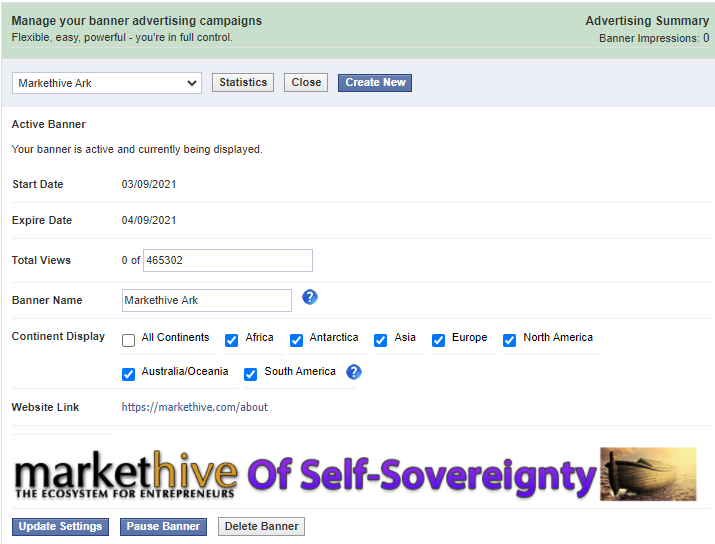
This banner service is for Entrepreneur Level Members Only and all members that have purchased banner impressions through the BIX.
In other words, anyone who is holding impressions in their Markethive account can create a banner that is displayed on what is considered AAA online real estate. The complete Markethive Network includes all pages, websites, and the many domains Markethive owns. This means your banners are viewed not just by members within Markethive but also by the vast internet traffic and onlookers.
Important to note: Some specific guidelines and qualifications need to be followed when creating a banner:
For more clarification on the banner creation and the guidelines, please refer to MARKETHIVE BANNERS SLIDES AND INFOGRAPHICS FREE & AVAILABLE.
Keep in mind these banners are viewed on the complete Markethive Network and all other systems we have, so the number of impressions any banner receives will be exponential.
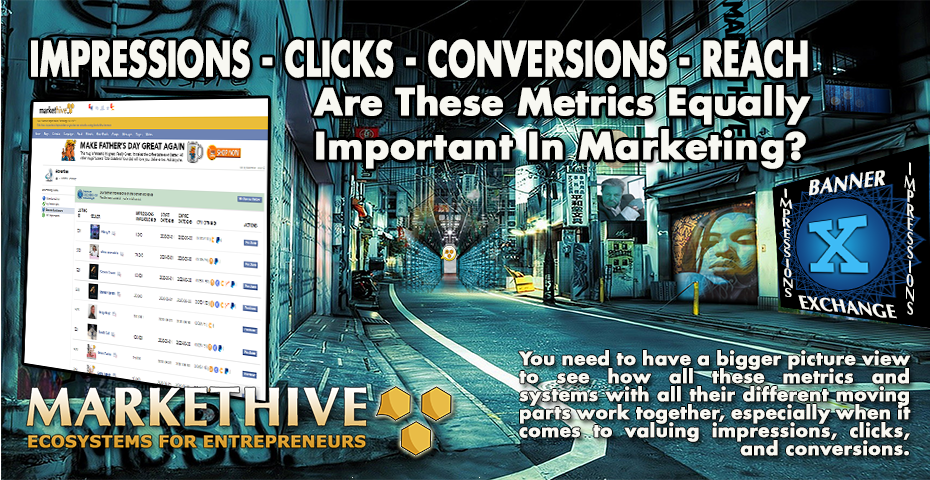
Many randomly post advertisements hoping they bring results without knowing the statistics of the process. Sorting out the data produced by an online advertising campaign can be an intimidating task, especially if you’re new to online advertising. If you’re a marketer, you will have heard of the terminology used to measure online ad campaign statistics. Still, it’s not always clear or understood how they are differentiated and why all metrics are equally important.
Many understand the importance of social media engagement; however, when it comes to strategy, it’s critical to know the difference between the key terms or metrics that are frequently used, as it will help you make sense of your campaign statistics. It’s all about accurately measuring your data to know what’s working and identifying areas where you can increase your efforts or improve on your content where it’s not working so well.
Reach is the total number of unique people who can see your ad or content. If 1000 people in total have seen your ad, that means your ad’s reach is 1000.
The advantage of having accounts on various social media platforms and a central system that allows you to broadcast your blog or advertisement to those individual platforms have the potential to increase your reach into the millions. Markethive, with its proprietary blogcasting system, is the springboard and gives you the ability to create massive reach, which is exponential and very powerful.
For example, If I subscribe to your blog and have 20,000 followers across all my social media accounts, and you have 15,000 subscribers, each with a similar following, your blogs have now been potentially seen by around 300,000,000 people, by-enlarge are not directly subscribed to you.
Every time you publish a blog with Markethive as the core platform, that article is posted to hundreds, even thousands of social network news feeds and WordPress sites.
Impressions are the number of times your content or advertisement is delivered and displayed on any given website or page. Let’s say that your ad from the previous example above popped up on those people’s screens a total of 3000 times. That means the number of impressions used for that ad is 3000.
Impressions are where your online advertising begins, and most likely where you will see the highest numbers as an impression is generated every time a web page is loaded and potentially viewed. It’s important to note that just because the banner was displayed doesn’t guarantee the visitor saw it.
It’s a bit like driving past a billboard on the side of the road, the ad is displayed continuously, but it doesn’t mean that you took any notice of it. So, in a sense, every car that passes the billboard would represent an impression, as the potential for the ad to be viewed is there but no guarantee that every driver saw it.
Impressions are typically used for displaying banner advertisements across the internet on any site that allows this type of advertising. This comes at a cost that varies across the board and is usually set by the management of the company website. See some comparisons here.
This protocol has now been preceded by a new unprecedented system, as Markethive, the social market network and ecosystem for entrepreneurs, has developed a Banner Impressions Exchange (BIX). It is advertising as a non-fungible token built into an exchange.
Are Impressions Important For Your Business?
Yes, they are the very foundation of the advertising process. They are essential for branding campaigns. Awareness is created from impressions, and continuing to drive impressions will be crucial to brand success. Increased impressions will lead to increased engagement and community size.
You can’t have reach or clicks without impressions first. Without impressions, which is the availability to view, there would be no clicks.
Clicks are usually seen as the most important step in the online advertising process, as a click means you have an interested visitor and a potential sale.
A click is recorded when a visitor clicks on your banner, takes them to your website, where a lead is captured, or the possibility of a sale. But when it comes to clicks, relative to impressions, you need the impressions to generate a click, and since not every person who views your banner (which is counted as an impression) will click on it, you will always have more impressions than clicks.
This ratio of clicks to impressions is measured by what’s known as the click-through rate (CTR). To calculate CTR, simply divide the number of clicks by the number of impressions.
For example, if your banner received 1,000 impressions and, out of that, you got 25 clicks, you would have a 2.5% CTR. The rule of thumb is that a banner with a high CTR effectively grabs a visitor’s attention, while a low CTR banner means that you may need to tweak something about the banner image or ad text to harvest more clicks, hopefully.
Your ideal ad click-through rate takes time to determine. It’s not the same for everyone, and the average CTR also depends on such factors as your industry and keywords and how competitive they are.
Based on the internal data of Wordstream, they’ve determined that the average CTR across all industries in Google Ads is 1.91% on the search network and 0.35% on the display network. The graphic below shows the variation in the average click-through rate for twenty different industries.
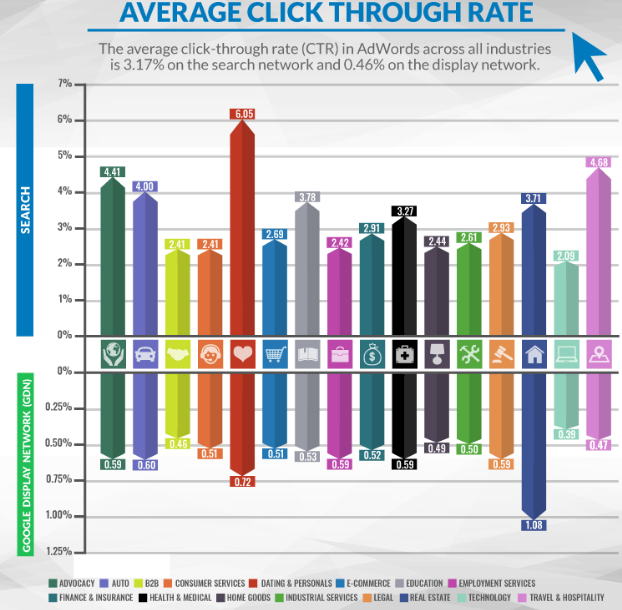
Image Credit - Wordstream
Conversions are the ultimate goal and end-result that every marketer sets out to accomplish.
Generating conversions means that the purpose of the advertisement/banner has been achieved. The term conversion covers a broad spectrum of actions, including capturing a lead, making a sale, or just having a visitor download an ebook or whitepaper. It’s good to measure the effectiveness of any campaign by determining how many conversions are achieved to how many dollars are spent. This calculates your return on investment (ROI).
When you’re analyzing your campaign data, it’s not a good idea to draw conclusions based upon only one metric. You always need to consider how each metric relates to the other.
For example, (1) you may have an ad with an exceptionally high CTR but a disheartening conversion rate. Conversely, (2) you may have an ad that gets very few clicks, but it almost always converts when it does.
The first scenario is not ideal because you’ll spend a lot of money on clicks but have little to show for it, especially if you’re using pay-per-click (PPC). The second scenario is not okay either because you won’t be able to scale that campaign to any significant size properly.
One of the most reliable ways to determine where best to channel your resources is by using a metric known as “Profit per Impression” (PPI). This metric takes both the beginning being impressions and ending being conversions or (profit) points of the advertising process. It uses them to determine the ultimate viability of an ad campaign.
This is particularly helpful when participating in Markethive’s Banner Impressions Exchange, where you can purchase impressions for your Banner Ad Campaigns and view the detailed statistics of any given active banner in your BIX section of Markethive.
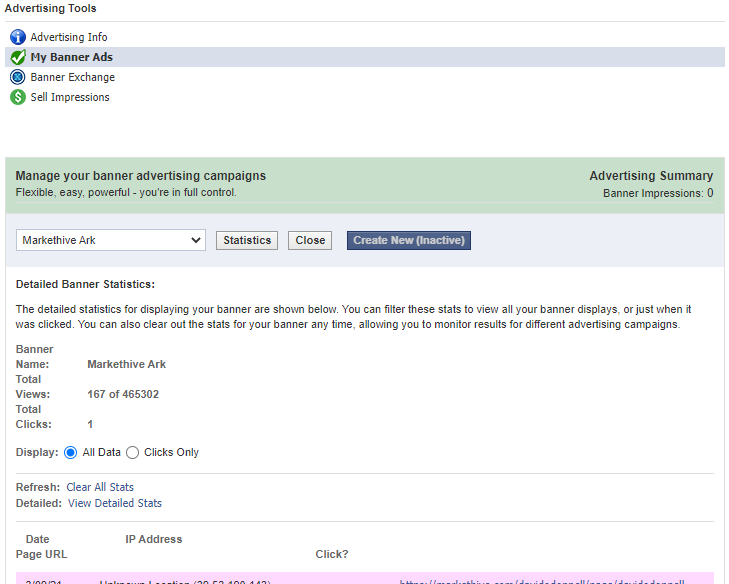
The way to calculate PPI is to simply find out how much profit (not revenue) you generated from a campaign and then divide that by the number of ad impressions it took to produce that profit.
For example, if it took a total of 90,000 impressions to produce $20,000 in profits, then your PPI would be $0.22 ($20,000 divided by 90,000 impressions). This enables you to see how well your banners perform after all costs have been covered. Campaigns with high PPIs will ultimately be the best candidates for scaling and growth.
By keeping the Profit per Impression (PPI) metric in mind gives you more confidence, and you will be more clear as to which ads will ultimately generate the most profit for your advertising campaign.
The Rule of 7 is a marketing principle that states that your prospects need to come across your offer at least seven times before they notice it and start to take action. Your prospects can be exposed to your offer significantly more than seven times, but they need to see it at least seven times.
This helps them remember you amongst an overwhelming amount of marketing messages, other information or clutter, and positions you to get better results from your marketing efforts. It’s not just about banners - social media and digital marketing require a thoughtful content strategy approach. This is accomplished by sharing content, interacting with people, and targeting ads to people interested in what you sell.
Socially-savvy companies like Markethive have the best of both worlds when it comes to marketing your business. It has the social newsfeed and specific storefront groups, inbound marketing tools, and now the banner impressions exchange. This gives you the ability to engage with prospects at every level of the buying process, as it’s been proven that the more positive contact you have, the easier it is to develop and sustain relationships and ultimately attain more sales.

So if the Rule of 7 involves encouraging repeat interactions with prospects, how do you do this?
With these initiatives in place, you will start to develop a level of visibility that will mean your prospects are being more frequently exposed to your brand. This can all be achieved and facilitated within the Markethive Platform utilizing its comprehensive range of marketing tools.
The result will be an increase in brand searches, increasing the number of inquiries, leading to a rise in sales. Don’t expect overnight results; this requires a consistent, long-term effort.
You need to have a bigger picture view to see how all these metrics and systems with all their different moving parts work together, especially when it comes to valuing impressions, clicks, and conversions. The best way to understand how these factors work together and track your results is to test and tweak your marketing campaigns continually.

Written by Deb Williams
Chief Editor and writer for Markethive.com, the social, market, broadcasting network. An avid supporter of blockchain technology and cryptocurrency. I thrive on progress and champion freedom of speech and sovereignty. I embrace "Change" with a passion, and my purpose in life is to enlighten people en masse, accept and move forward with enthusiasm.
